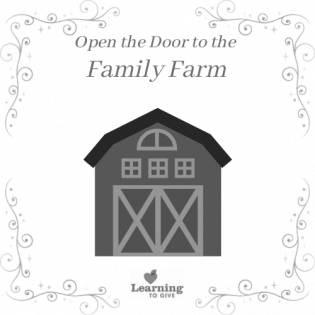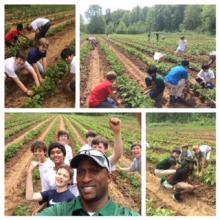Open the Door to the Family Farm or Farmers' Market
The "Open Doors to Your Community" project is a virtual door that guides young people to the actual door of local resources so they can learn about their community, take action, and build connections and understanding of their roles in community.
What Is the Purpose of a Farm or Farmers Market?
Family farmers grow a variety of produce or raise animals for food. They sell what they produce locally or nationally. Some farms stay in families for generations. We need family farms that support their communities while using practices that are good for the soil and air. Larger company-run farms can often produce large quantities of food more cheaply and transport them widely. This makes it hard for family farms to make money and stay in business. Some family farms find creative ways to support their farm business by attracting visitors, having a farm market, or raising unusual foods or animals.Meet a Family Farmer
In this brief video, we meet Rob Recknagel, from Lewis Adventure Farm and Petting Zoo in New Era, Michigan. He shares how their farm produces a large variety of fruits and vegetables as well as cares for a variety of animals. The farm has been cared for by five generations of the Lewis family. They decided to get creative by welcoming families to visit the farm and have fun petting animals, viewing innovative machinery, buying food, and learning about unusual animals. The farm provides many opportunities for young volunteers to make connections in the community and learn about farming.
Contact Your Local Family Farm or Farmers' Market
Look up farm-related businesses or nonprofits nearby where you can learn about growing vegetables and fruits or caring for animals. This may be a small family farm, a Community Sustained Agriculture (CSA) business, a farmers' market, or a community garden. Call to set up a phone or in-person interview. Tell them you'd like to learn more about the work of the farm and best practices so you can get involved or volunteer to help their mission. Ask for 30 minutes or an hour of their time. The Interview Script linked here and below can help you make the call.Interview Questions
These questions can help you learn about your community and ways you can get involved.
- What is the main purpose of a family farm? This may be its mission or vision.
- What are some challenges that farmers face?
- What are some choices people can make to support farming and good practices?
- What can a young person do to participate in the community around a family farm?
Take Action in Your Community
Reflect on the work of the farm and farm families. What can you help them do? Your voice and time matter. The resources below can help you plan a project.
The best service-learning projects guide us to gain and use knowledge, are led by youth voice and passion, address a need, and develop connections with local resources over time.
 Learning to Give Issue Area Toolkits include background on the issue, community connections, lessons and activities, project ideas, and planning guides. Check out the Hunger and Malnutrition toolkit as well as the Humans and the Environment toolkit.
Learning to Give Issue Area Toolkits include background on the issue, community connections, lessons and activities, project ideas, and planning guides. Check out the Hunger and Malnutrition toolkit as well as the Humans and the Environment toolkit.
 Learning to Give Service Sparks guides provide directions for generous actions that encourage youth voice and promote the common good. Check out the Grow Something to Give service project here. This is an opportunity to start your own community garden or connect with an organization increasing fresh food access in food deserts.
Learning to Give Service Sparks guides provide directions for generous actions that encourage youth voice and promote the common good. Check out the Grow Something to Give service project here. This is an opportunity to start your own community garden or connect with an organization increasing fresh food access in food deserts.
 Learning to Give Literature guides combine selected literature with thought-provoking discussions and activities that teach about giving and civic engagement. Read aloud a picture book to a younger child or a retirement home buddy and talk about the community themes. The picture book Harvesting Hope tells about migrant farm families and Cesar Chavez who spoke up for their rights. If You Plant a Seed is a garden metaphor for growing kindness. Temple Grandin, a woman with autism, solved a farm problem related to cows because she used her creative brain to empathize with the cows in the book The Girl Who Thought in Pictures.
Learning to Give Literature guides combine selected literature with thought-provoking discussions and activities that teach about giving and civic engagement. Read aloud a picture book to a younger child or a retirement home buddy and talk about the community themes. The picture book Harvesting Hope tells about migrant farm families and Cesar Chavez who spoke up for their rights. If You Plant a Seed is a garden metaphor for growing kindness. Temple Grandin, a woman with autism, solved a farm problem related to cows because she used her creative brain to empathize with the cows in the book The Girl Who Thought in Pictures.
More about Family Farms
Fun Facts:
- There are about 2 million family farms in the U.S.
- About half of the family farms are run by women, at least in part.
- A full-grown Holstein cow can produce up to 60 pounds of milk in a day.
- The Michigan Farm Bureau offers a young farmer program for 18-35 year-olds that develops them as agricultural leaders.
Other Services Family Farms Provide:
- petting zoo or farm and exotic animals
- corn maze
- market for homemade goods
- games and family fun activities
- classes and learning experiences, such as canning, quilting, flower arranging, and baking


